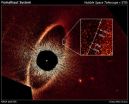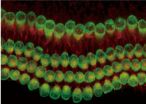(Press-News.org) Newly released NASA Hubble Space Telescope images of a vast debris disk encircling the nearby star Fomalhaut and a mysterious planet circling it may provide forensic evidence of a titanic planetary disruption in the system.
Astronomers are surprised to find the debris belt is wider than previously known, spanning a section of space from 14 to nearly 20 billion miles from the star. Even more surprisingly, the latest Hubble images have allowed a team of astronomers to calculate the planet follows an unusual elliptical orbit that carries it on a potentially destructive path through the vast dust ring.
The planet, called Fomalhaut b, swings as close to its star as 4.6 billion miles, and the outermost point of its orbit is 27 billion miles away from the star. The orbit was recalculated from the newest Hubble observation made last year.
"We are shocked. This is not what we expected," said Paul Kalas of the University of California at Berkeley and the SETI Institute in Mountain View, Calif.
The Fomalhaut team led by Kalas considers this circumstantial evidence there may be other planet-like bodies in the system that gravitationally disturbed Fomalhaut b to place it in such a highly eccentric orbit. The team presented its finding Tuesday at the 221st meeting of the American Astronomical Society in Long Beach, Calif.
Among several scenarios to explain Fomalhaut b's 2,000-year-long orbit is the hypothesis that an as yet undiscovered planet gravitationally ejected Fomalhaut b from a position closer to the star, and sent it flying in an orbit that extends beyond the dust belt.
"Hot Jupiters get tossed through scattering events, where one planet goes in and one gets thrown out," said co-investigator Mark Clampin of NASA's Goddard Space Flight Center in Greenbelt, Md. "This could be the planet that gets thrown out."
Hubble also found the dust and ice belt encircling the star Fomalhaut has an apparent gap slicing across the belt. This might have been carved by another undetected planet. Hubble's exquisite view of the dust belt shows irregularities that strongly motivate a search for other planets in the system.
If its orbit lies in the same plane with the dust belt, then Fomalhaut b will intersect the belt around 2032 on the outbound leg of its orbit. During the crossing, icy and rocky debris in the belt could crash into the planet's atmosphere and create the type of cosmic fireworks seen when Comet Shoemaker-Levy 9 crashed into Jupiter. Most of the fireworks from collisions will be seen in infrared light. However, if Fomalhaut b is not co-planar with the belt, the only thing to be seen will be a gradual dimming of Fomalhaut b as it travels farther from the star.
Kalas hypothesized that Fomalhaut b's extreme orbit is a major clue in explaining why the planet is unusually bright in visible light, but very dim in infrared light. It is possible the planet's optical brightness originates from a ring or shroud of dust around the planet, which reflects starlight. The dust would be rapidly produced by satellites orbiting the planet, which would suffer extreme erosion by impacts and gravitational stirring when Fomalhaut b enters into the planetary system after a millennium of deep freeze beyond the main belt. An analogy can be found by looking at Saturn, which has a tenuous, but very large dust ring produced when meteoroids hit the outer moon Phoebe.
The team has also considered a different scenario where a hypothetical second dwarf planet suffered a catastrophic collision with Fomalhaut b. The collision scenario would explain why the star Fomalhaut has a narrow outer belt linked to an extreme planet. But in this case the belt is young, less than 10,000 years old, and it is difficult to produce energetic collisions far from the star in such young systems.
Fomalhaut is a special system because it looks like scientists may have a snapshot of what our solar system was doing 4 billion years ago. The planetary architecture is being redrawn, the comet belts are evolving, and planets may be gaining and losing their moons. Astronomers will continue monitoring Fomalhaut b for decades to come because they may have a chance to observe a planet entering an icy debris belt that is like the Kuiper Belt at the fringe of our own solar system.
INFORMATION:
For more information and for related images, please visit:
www.nasa.gov/hubble
and
http://hubblesite.org/news/2013/01
NASA's Hubble reveals rogue planetary orbit for Fomalhaut B
2013-01-09
ELSE PRESS RELEASES FROM THIS DATE:
Nursing gerbils unravel benefit of multiple mothers in collective mammals
2013-01-09
In mammals such as rodents that raise their young as a group, infants will nurse from their mother as well as other females, a dynamic known as allosuckling. Ecologists have long hypothesized that allosuckling lets newborns stockpile antibodies to various diseases, but the experimental proof has been lacking until now.
An in-press report in the journal Mammalian Biology found that infant Mongolian gerbils that suckled from females given separate vaccines for two different diseases wound up with antibodies for both illnesses.
The findings not only demonstrate the potential ...
Scientists peer into a brown dwarf, find stormy atmosphere
2013-01-09
A University of Arizona-led team of astronomers for the first time has used NASA's Spitzer and Hubble space telescopes simultaneously to peer into the stormy atmosphere of a brown dwarf, creating the most detailed "weather map" yet for this class of strange, not-quite-star-and-not-quite-planet objects. The forecast shows wind-driven, planet-sized clouds enshrouding these strange worlds.
Brown dwarfs form out of condensing gas like stars but fail to accrue enough mass to ignite the nuclear fusion process necessary to turn them into a star. Instead, they pass their lives ...
Asteroid belt found around Vega
2013-01-09
Vega, the second brightest star in northern night skies, has an asteroid belt much like our sun, discovered by a University of Arizona-lead team of astronomers. A wide gap between the dust belts in nearby bright stars is a strong hint of yet-undiscovered planets orbiting the stars.
The findings from the Infrared Space Telescopes are the first to show an asteroid-like belt ringing Vega. The discovery of an asteroid belt around Vega makes it more similar to its twin, a star called Fomalhaut, than previously known. Both stars now are known to have inner, warm asteroid belts ...
JCI early table of contents for Jan. 9, 2013
2013-01-09
Small peptide ameliorates autoimmune skin blistering disease in mice
Pemphigus vulgaris is a life-threatening autoimmune skin disease that is occurs when the body's immune system generates antibodies that target proteins in the skin known as desomogleins. Desmogleins help to form the adhesive bonds that hold skin cells together and keep the skin intact. Currently, pemphigus vulgaris is treated by long-term immune suppression; however, this can leave the patient susceptible to infection. In this issue of the Journal of Clinical Investigation, researchers led by Jens Waschke ...
Small peptide ameliorates autoimmune skin blistering disease in mice
2013-01-09
Pemphigus vulgaris is a life-threatening autoimmune skin disease that is occurs when the body's immune system generates antibodies that target proteins in the skin known as desomogleins. Desmogleins help to form the adhesive bonds that hold skin cells together and keep the skin intact. Currently, pemphigus vulgaris is treated by long-term immune suppression; however, this can leave the patient susceptible to infection. In this issue of the Journal of Clinical Investigation, researchers led by Jens Waschke at the Institute of Anatomy and Cell Biology in Munich, Germany, ...
Newly found 'volume control' in the brain promotes learning, memory
2013-01-09
WASHINGTON — Scientists have long wondered how nerve cell activity in the brain's hippocampus, the epicenter for learning and memory, is controlled — too much synaptic communication between neurons can trigger a seizure, and too little impairs information processing, promoting neurodegeneration. Researchers at Georgetown University Medical Center say they now have an answer. In the January 10 issue of Neuron, they report that synapses that link two different groups of nerve cells in the hippocampus serve as a kind of "volume control," keeping neuronal activity throughout ...
A new treatment for kidney disease-associated heart failure?
2013-01-09
Chronic kidney disease (CKD) patients frequently suffer from mineral bone disorder, which causes vascular calcification and, eventually, chronic heart failure. Similar to patients with CKD, mice with low levels of the protein klotho (klotho hypomorphic mice) also develop vascular calcification and have shorter life spans compared to normal mice. In this issue of the Journal of Clinical Investigation, Florian Lang and colleagues at the University of Tübingen in Germany, found that treatment with the mineralocorticoid receptor antagonist spironolactone reduced vascular calcification ...
Fusion gene contributes to glioblastoma progression
2013-01-09
Fusion genes are common chromosomal aberrations in many cancers, and can be used as prognostic markers and drug targets in clinical practice. In this issue of the Journal of Clinical Investigation, researchers led by Matti Annala at Tampere University of Technology in Finland identified a fusion between the FGFR3 and TACC3 genes in human glioblastoma samples. The protein produced by this fusion gene promoted tumor growth and progression in a mouse model of glioblastoma, while increased expression of either of the normal genes did not alter tumor progression. Ivan Babic ...
Regeneration of sound sensing cells recovers hearing in mice with noise-induced deafness
2013-01-09
Extremely loud noise can cause irreversible hearing loss by damaging sound sensing cells in the inner ear that are not replaced. But researchers reporting in the January 9 issue of the Cell Press journal Neuron have successfully regenerated these cells in mice with noise-induced deafness, partially reversing their hearing loss. The investigators hope the technique may lead to development of treatments to help individuals who suffer from acute hearing loss.
While birds and fish are capable of regenerating sound sensing hair cells in the inner ear, mammals are not. Scientists ...
Mathematics and weather and climate research
2013-01-09
San Diego, California – January 9, 2013 – How does mathematics improve our understanding of weather and climate? Can mathematicians determine whether an extreme meteorological event is an anomaly or part of a general trend? Presentations touching on these questions will be given at the annual national mathematics conference in San Diego, California. New results will also be presented on the MJO (pronounced "mojo"), a tropical atmospheric wave which governs monsoons and also impacts rainfall in North America, and yet does not fit into any current computer models of the ...

